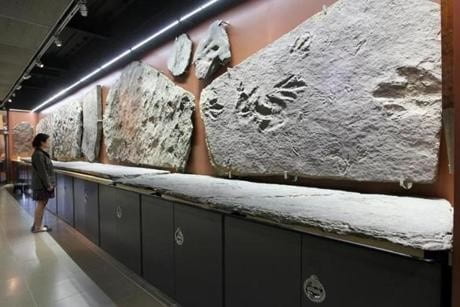Last (last) week, we had the opportunity to take a tour of Edward Hitchcock’s contributions to the Beneski Museum of Natural History, guided by the wonderful and extremely knowledgable Kate Wellspring. I’ve been to the Beneski Museum several times in the past, both for classes and on my own, and I thought I had a pretty good sense of the collection (HA, even writing that statement now, the naivete is painful) and what it contained. Mineral samples, drawings of the Oxbow, and of course the ubiquitous Ichnology Collection of Edward Hitchcock that lines the walls of the ground floor in massive slabs of footprinted stone.
And on those points, I certainly wasn’t disappointed: all of the exhibits and artifacts I’d perused before were still there, but my experience of them was markedly different than it had been in the past. Instead of wandering through and skimming the object labels that held my fleeting interest, I experienced a much more active and energetic interaction with the museum, thanks to Kate’s guidance. Kate not only seems to know just about everything there is to know about Hitchcock, she’s also incredibly enthusiastic about the topic of his life.
As Kate led us around the museum, stopping to give us details about the objects and exhibits that I had seen and passed by times before, I found myself much more engaged and attentive than I had been in the past. Granted, this change in my interest is most primarily explained by the fact that I’ve been living and breathing (nearly) Hitchcock for the past three weeks: in terms of audience, I/we the group was/were the ideal audience for Kate’s tour, given that we are actively and, one could say, urgently interested in learning about Hitchcock.
But outside of current situational elements that make me more engaged with the Hitchcock-related exhibits than I have been in the past, there was something about Kate’s energy and enthusiasm during the tour that made me even more actively interested than I think I would have been on my own. In addition to the basic explanation of each Hitch-related object she showed us, Kate would offer anecdotes from Hitchcock’s life, details on his relationships and personality, and her own commentary on what she thought it all meant. (For an example, when showing us all of the places Hitchcock traveled around New England to do geological surveys, Kate added that he was a very active man, despite his hypochondria, and would walk all over the countryside. “I think he probably needed to get out of the house and away from all those kids,” she quipped, referring to the full house of his and Orra’s children.)
I would say that this tour made Hitchcock feel like a real person to me, but I think I reached that milestone after reading his records of loans to his kids and some of his notes to Orra. Rather, I began to realize that Hitchcock was not just a real person, but a real person who I don’t and can’t really ever know: for all I’ve read about him so far, he can still surprise me; there is still learning to be had here, I just needed to be directed toward it by an authority, i.e. Kate.
I’ve been thinking about our/my experience with Kate at the Beneski Museum as an analogue for how our ideal exhibit would work: in the midst of the ocean of information contained in the Hitchcock Collection, our exhibit (or map, or data analysis, or combination of whatever) should be a guide, providing a unique and interesting narrative that the visitor could not just get from reading the Edward Hitchcock Wikipedia article.
On the other side of things, the exhibit should also leave room for the audience to explore (dare I say browse) and discover some things on their own. I keep having to remind myself that planning this project is not like planning a paper: there should be less of a rigid structure and more than one endpoint for the audience to come to.
Similarly, I continually have to remind myself that the research question that we will finally/soon embark upon doesn’t necessarily have to be a single or fixed question. After a week (this past one) of brainstorming about how on earth we were going to funnel all of our interests into a single question, this week we’re trying a more experimental approach, and allowing ourselves to explore what interests us and seems relevant in the collection and various secondary sources, with the hope that near the end of the week we can come together with more articulable ideas of what is more/less fruitful to research in-depth. I’m looking forward to the less-structured time, although I’m not sure I even know which direction to go off in. I still feel like I don’t know enough about the time and place and context of Hitchcock’s life (esp. in relation to the college, as they seem so inextricably linked in my and I think I can say the group’s mind[s]), and I think it might be most helpful to start there, with secondary sources and see where Hitchcock comes through the most.
